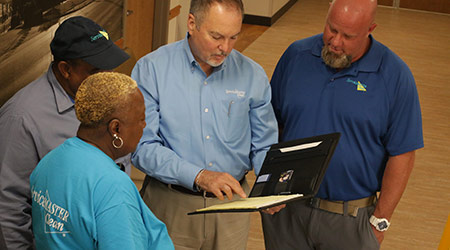Rural hospitals face the same challenges as large metropolitan hospitals, yet they are often far apart when it comes to resources.
Just like urban hospitals, rural hospitals must provide quality healthcare for the ill and injured, meet all federal and state regulations, keep up with new and changing technologies, and do all of this within budget. But most rural hospitals have limited resources, certainly less than their big-city counterparts, and they sometimes struggle to attract qualified medical professionals.
“Managing a rural hospital is very challenging and it’s not getting less complicated,” said Blake Kramer, administrator of the 34-bed Franklin Medical Center (FMC) in Winnsboro, La.
Like many directors at rural public hospitals, Kramer is always seeking ways to improve services and outcomes for patients. One area he and the hospital’s board of directors closely scrutinized was environmental services (EVS). Would outsourcing improve hospital cleanliness, enhance patient care, control costs and perhaps improve their HCAHPS1 scores?
“We wanted to change our processes and culture with regard to infection control and environmental services,” said Kramer. “We needed a professional advisor who could help us in these areas.”
According to Kramer, outsourcing raised some important questions. Cost, staffing, process integration, compliance, reporting… all were concerns as they explored outsourcing options. They considered hiring a consultant but determined that a consultant would not provide the daily oversight and staff training they needed.
A bidder for the hospital’s EVS work was ServiceMaster Action Cleaning from nearby Monroe, Louisiana. The company had healthcare experience and extensive training in infection control, plus they were willing to retrain the existing FMC environmental services staff to preserve local jobs. ServiceMaster Action Cleaning was already knowledgeable about local, state and federal regulations. They also proposed to modernize the environmental services process, provide new equipment and have a trained environmental services supervisor at the facility every week. All this on an EVS budget that was manageable for the hospital.
Clean culture
Changing the cleaning culture at any hospital requires buy-in at all levels – management, clinical and environmental services. According to the new EVS provider, it starts with a change in mind set.
“We consider ourselves the first line of defense against infection,” said Terry Howard, vice president for environmental services for ServiceMaster Action Cleaning and the man responsible for the transition at Franklin Medical Center. “Sure, we clean floors, but eliminating pathogens and preventing infection are what we train to do.”
Howard noted that the existing staff at FMC was both willing and able to adapt to new environmental services methods. All except one EVS staffer chose to stay at the hospital under new EVS leadership.
Their training included both new techniques and new technologies. The new environmental services protocol rid the hospital of old-fashioned mops and brooms in favor of microfiber mops that trap and control dust and absorb liquids. Once used, the pads are disposed of rather than cleaned and reused. The crews also use vacuums to eliminate airborne particles which can irritate allergies or even spread infection. All surfaces are wiped down daily using approved, hospital-grade disinfectants, and label instructions are followed carefully with regard to application and dwell times. EVS personnel now follow a “high-to-low” cleaning process, starting at the ceiling and working downward; this also to help prevent the spread of pathogens. Hand hygiene is a top priority and they always use approved personal protective equipment.
Furthermore, the EVS team now has new equipment, such as a self-propelled ride-on floor cleaning machine, backpack vacuums and disposable dust-free cleaning pads.
To further change the EVS staff’s culture, their training included sessions on patient interaction. As Howard noted, “the ultimate goal of our work is to improve patient satisfaction, and that includes patient relationships.” The EVS staff practiced greeting patients warmly whenever they enter a room while explaining the purpose of their visit.
How did the staff respond to this new direction? “They were very willing and eager to accept training and new ways of doing things. It was clear they wanted to excel at their jobs,” said Howard.
Tangible results
Now, three years into the program, the results speak for themselves.
-
HCAHPS scores are up. From 2012-2015, the hospital’s cleanliness scores were generally around 70 percent. Now they are routinely around 90 percent, higher than nearly all other hospitals in their region.
-
Efficiency has improved. With better communication, training and technology, more cleaning is being done in less time with fewer staff. “We spend far less time on environmental service issues and more time on patient care than we used to,” said Jason Emfinger, assistant director of nursing at FMC.
-
No HAIs have been reported. Since the inception of the new program, there have been zero reports of hospital acquired infections at Franklin Medical Center.
-
Compliance regulation achieved. The hospital is in full compliance with all environmental services regulations.
-
Staff morale is high. Clinical and EVS staff report excellent morale and better communication than ever before.
-
The value is evident. The hospital spends slightly more on EVS services than it did three years ago, but all the EVS staff received a pay raise at the transition, a great morale booster. The hospital got new, modern cleaning equipment and sources of infection have been eliminated, which reduces potential liabilities. Perhaps most important, FMC’s reputation for quality healthcare has never been higher.
Patient approval
Franklin Medical Center is like most rural hospitals; the challenges increase every year but the need for quality local healthcare remains consistent. FMC found a way to enhance its operation, improve patient care and make everyone proud of their hospital.
“About eight months after we brought in ServiceMaster Action Cleaning to manage our environmental services, we had an elderly lady admitted to the hospital,” said FMC administrator Kramer. “Her granddaughter was decidedly not a fan of Franklin Medical Center due to past experiences here. However, after a day or so, her opinion changed completely, largely because of the cleanliness of the facility and the experience she had with the staff, including the EVS team. She made a point to tell me how pleased she was her family’s experience here. I attribute much of her attitude change to the performance of the EVS team.”
Steve Zimmerman, MBA, CHESP, T-CSCT is Director of Healthcare Services for ServiceMaster Clean, a provider of professional healthcare environmental services. He can be reached at szimmerman@smclean.com.
-
HCAHPS – Hospital Consumer Assessment of Healthcare Providers and Systems.
-
https://www.ruralhealthweb.org/about-nrha/about-rural-health-care

 Building Disaster Resilience Through Collaboration
Building Disaster Resilience Through Collaboration Amae Health Expands to New York City
Amae Health Expands to New York City Hospital for Special Surgery Opens Two New Facilities in New Jersey
Hospital for Special Surgery Opens Two New Facilities in New Jersey Should We Be Testing Toilet Water in Patient Restrooms?
Should We Be Testing Toilet Water in Patient Restrooms? Healthcare Union Petitions for Increased Staff Safety at HCA Florida Hospitals
Healthcare Union Petitions for Increased Staff Safety at HCA Florida Hospitals